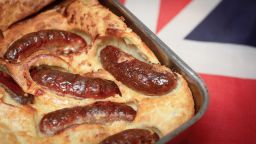CNN
—
Fried breakfast. Sunday lunch. Fish and chip supper. Any member of this holy triumvirate might qualify for the title of Britain’s National Dish. Except that Britain’s real signature plate isn’t served on a plate at all, but from a metalized plastic bag. It doesn’t sizzle or boil, but rustles and crunches — a greasy airbag of impetuous gratification, snacky saline satisfaction, and ultimately, empty calories.
This is the story of the crisp — the wafer-thin sliced, deep-fried slivers of seasoned potato that continue to hook millions, and stole the hearts of a nation in more ways than one.
An unhealthy obsession
Tune into BBC Radio 6 Music on a Sunday morning, and between tunes from CMAT and Radiohead, you may well hear the sound of someone nibbling on crisps. The presenters Marc Radcliffe and Stuart Maconie have not been caught off guard snacking between tracks however; “Crisps on the Radio” is a long-running segment on their morning show, in which listeners mail in packets of crisps they’ve discovered from around the world, and Radcliffe and Maconie attempt to work out what flavor they’re supposed to be.
This whimsical use of airtime underscores Brits’ unparalleled affinity with the crisp, a snack that is infinitely more than just a snack. Britons consume some 10 billion bags of crisps each year. On weekday lunchtimes, walls of crisps are raided from British supermarkets, as workers grab a bag as part of a “meal deal.” Picnics in the park are considered piteous without the addition of a family-sized bag of crisps. Online commentators endlessly shuffle crisps into tiers of deliciousness, while stand-up comedians count the ways in which people finish off the crumbly remnants of their crisp packet.
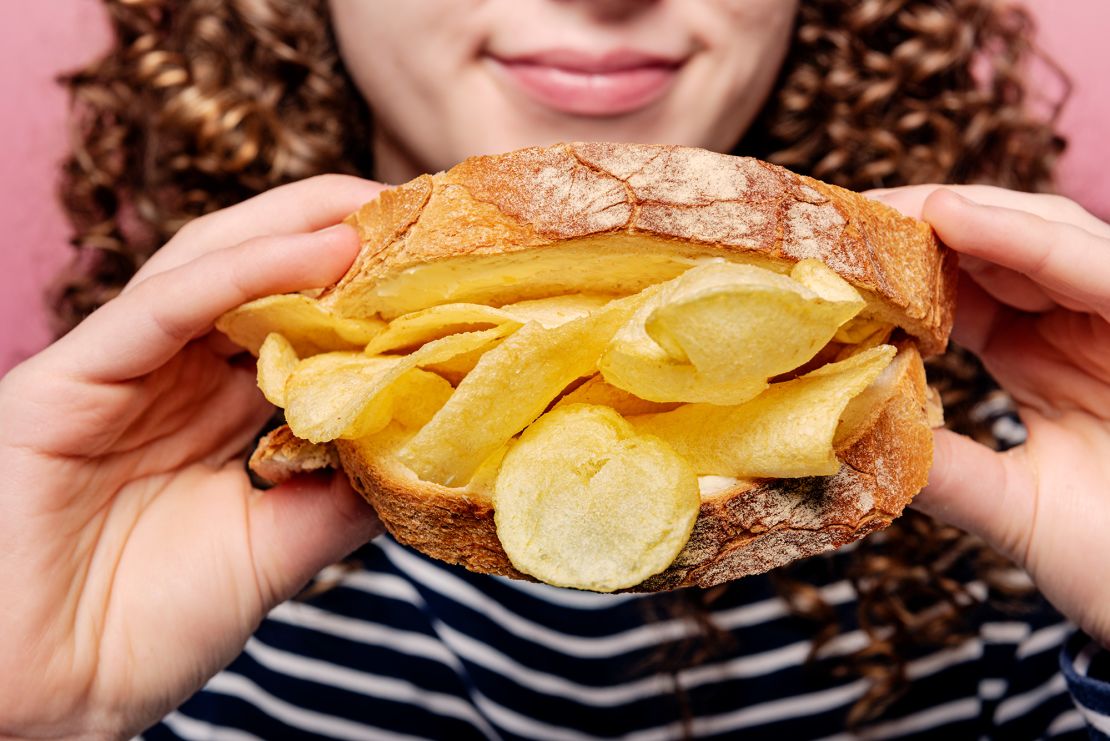
In 2022, Nigella Lawson, one of the country’s most adored TV cooks, teamed up with Walkers — the nation’s best-selling crisps brand — to create a recipe for the perfect crisp sandwich (ingredients: bread, butter, crisps). The next year, Kicks Bar and Grill in Hull, in the northeast of England inveigled customers through its doors with an all-you-can-eat crisp buffet. In her 2024 book “Crunch: An Ode to Crisps,” Natalie Whittle writes: “It is hard to escape the strange connective force of crisps in British life.”
You might say the Brits have an unhealthy obsession with the crisp. But how did it get here in the first place? The answer is: it came from America. Sort of.
Rustling up a treat
It’s an origin story worthy of Hollywood. The setting: Moon’s Lake House restaurant in Saratoga Springs, New York, 1853. The main players: chef George Crum, and diner/railway tycoon/fussy eater Cornelius Vanderbilt. The tale goes that Vanderbilt demanded Crum cut his potatoes thinner… and thinner… and thinner. Crum eventually blew his top, shaved the potatoes passive-aggressively thin with a mandolin, and sent them back out to the customer in spite. Except that Vanderbilt loved these crackly scraps of salted spud, and thus “Saratoga Chips” were born.
It’s likely this anecdote was bent into more pleasing shape over time — for one thing, Crum’s sister Catherine Adkins Wicks always maintained she’d been the one manning the frying pan, not Crum — but it’s true that someone at Moon’s Lake House sliced those potatoes wafer thin, and it’s also true that, before the century was out, industrious business folk like William Tappenden had pounced on the snack’s potential as a store-sold item, not just a restaurant specialty.
Any Brits in need of a lie down after hearing this distinctly un-British backstory, however, can breathe easy. Technically, the crisp had already been invented over in England; here, in 1817, the first known crisp recipe was published in William Kitchiner’s “The Cook’s Oracle” as “Potatoes fried in Slices or Shavings”:
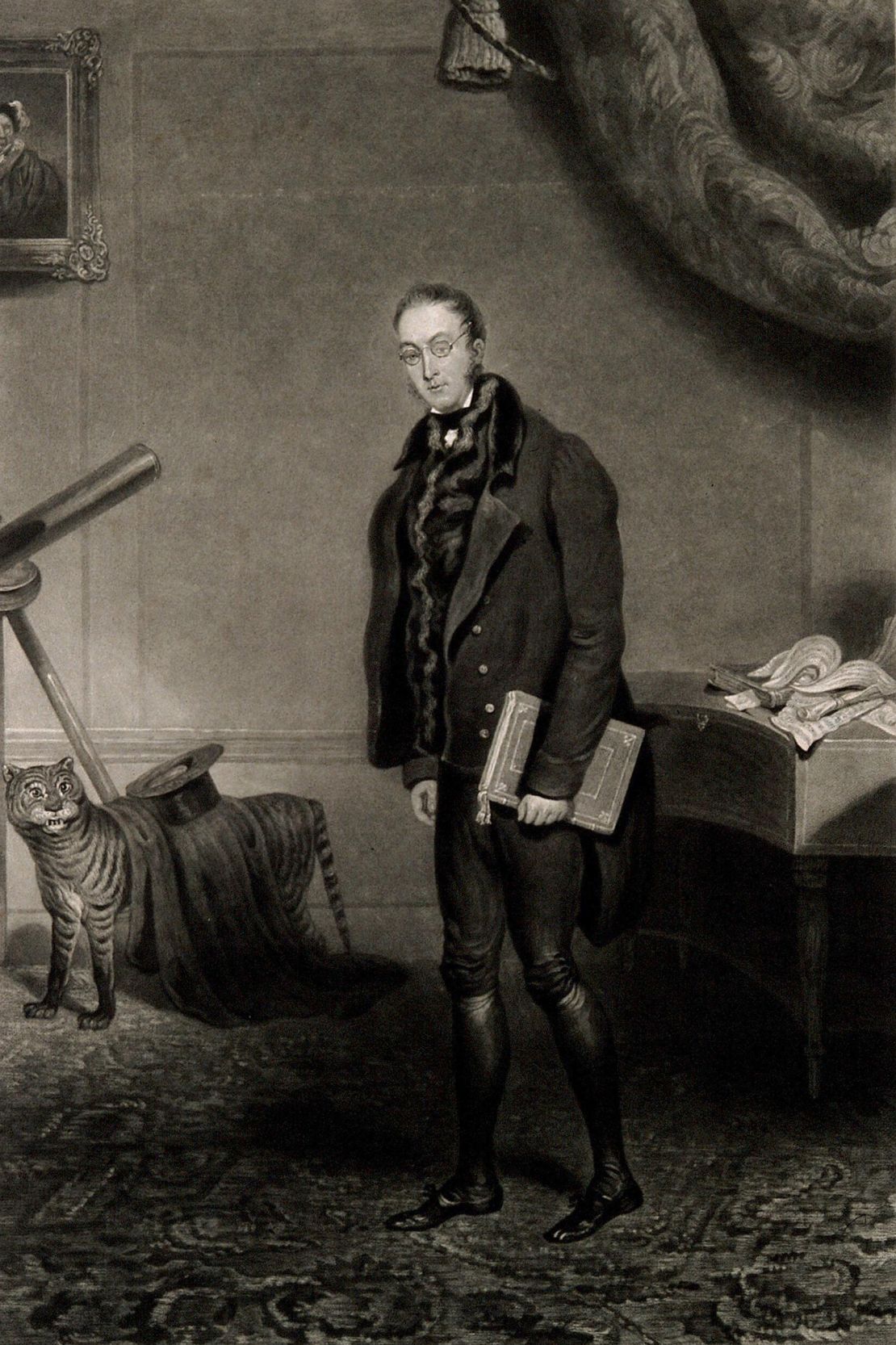
“Peel large potatoes; slice them about a quarter of an inch thick, or cut them in shavings round and round, as you would peel a lemon; dry them well in a clean cloth, and fry them in lard or dripping….”
Kitchiner, who was born and died in London, is also known for whipping up the first-ever batch of Wow-Wow Sauce. The fact he was also a doctor may raise eyebrows now, given the crisp’s dubious health implications. It may be that only a handful of Brits ever tried Kitchiner’s crisp recipe anyway — but he does appear to have got there before anyone else, American or otherwise.
And while commercially shrewd America had a headstart when it came to marketing the potato chip in the late 19th/early 20th century, Britain took up the baton full-heartedly in 1920, thanks to the entrepreneur Frank Smith, who converted two garages in the north London suburb of Cricklewood into the country’s first crisp factory. Smith’s real breakthrough though was a delightfully simple one. As pub landlords quickly grew annoyed that their customers were stealing salt shakers in order to season their slivers of fried potato, Smith introduced a twist of blue paper, each containing a pinch of salt, and added to every greaseproof bag.
Now the British crisp was really cooking, and by the time the country was through with World War II, the market had grown hungrier than ever. Edinburgh’s Golden Wonder and Sunderland’s Tudor crisp companies arrived on the scene in 1947. The following year, Henry Walker, a butcher in the central English city of Leicester, pivoted his business to make hand-sliced crisps. That same company now produces over 11 million bags of crisps a day.
A man for all seasonings
But there was an elephant in the room. The crisp was relentlessly monotone. You could have any flavor, as long as it was salted/unsalted. Neither the Americans nor the Brits solved this particular issue. That was a job for Dublin-born Joe “Spud” Murphy, who shunned a life in the priesthood (“To hell with this, we need one sinner in the family”) and instead formed the Tayto crisp company, in 1954. Sick to the back teeth of plain crisps, Murphy made his first point of order to add a seasoning powder to his Taytos, namely Cheese and Onion. The people went for it, boosted by early marketing campaigns which advised these crisps were the ideal accompaniment to salads… and fried breakfasts. The Smith’s salt sachet suddenly seemed altogether quaint.
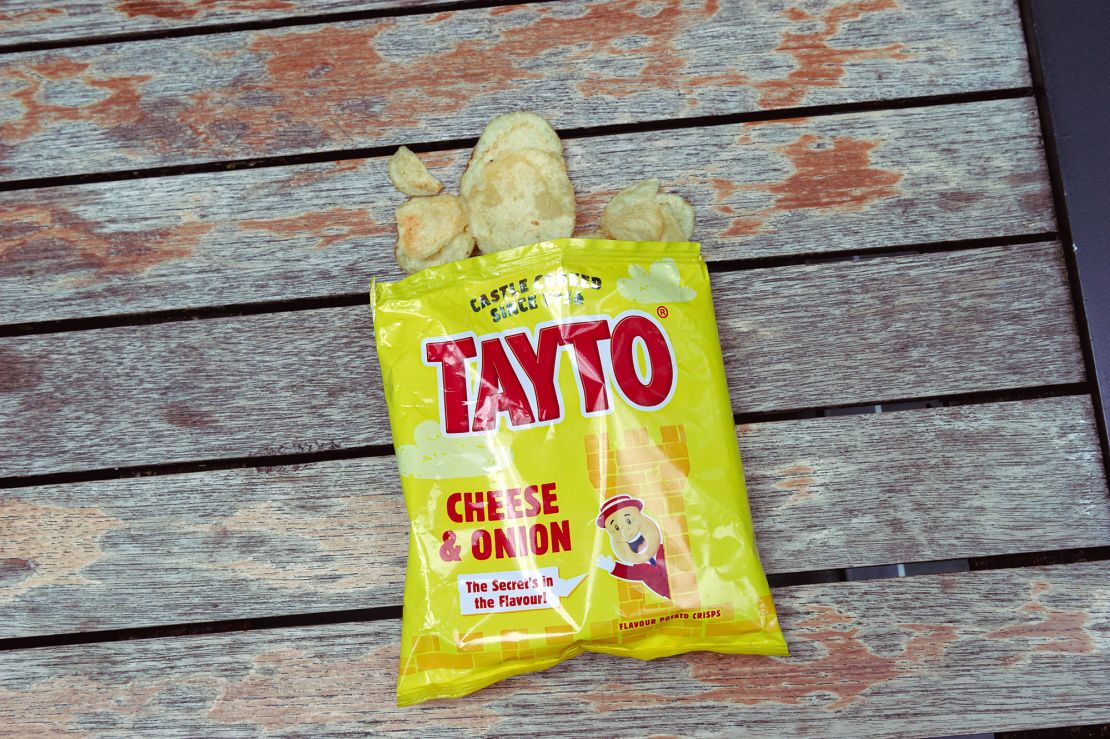
Golden Wonder copied Tayto with its own Cheese and Onion offering. Then, in 1967, Tudor (by now a subsidiary of Smith’s) released the first Salt and Vinegar crisps, a tongue-tingling seasoning that remains a stalwart today. More riotous flavors followed, albeit still geared towards British/Irish palates: Pickled Onion, Lamb & Mint Sauce, Curry, Gammon & Pineapple. A 1981 episode of the BBC consumer TV show “That’s Life!” thrust unmarked bowls of crisps in front of unsuspecting members of the public, inviting them to guess the flavor (perhaps that’s where “Crisps on the Radio” got its idea from). “It’s not snake is it?” ventured one gentleman, chewing timidly on a prawn cocktail crisp.
Crisp lovers were now tasting in Technicolor, and in the same year the “That’s Life!” episode aired, flavors really jumped the shark — in fact another animal altogether — thanks to Hedgehog-flavoured crisps, the barmy brainchild of pub landlord Phillip Lewis. Lewis was soon after forced to tweak the name to Hedgehog Flavour Crisps, because they did not in fact contain hedgehog, but he’d made his point: anything in the world of crisps was possible.
Crisp culture
In the 1980s the crisp became a staple of British life. The punk band Splodgenessabounds released “Two Pints of Lager and a Packet of Crisps Please”, a distorted paean to a common order down the local pub. Come the middle of the decade, Brits were splashing an extraordinary £805m (over a billion dollars) on crisps and snacks alone.
Companies upped the ante with TV commercials. Walkers — by now pulling away from the competition — called in the big guns. The veteran English comedian Ronnie Barker asked viewers “Don’t you insist on Walkers crisps?”. What turned out to be the ultimate coup for Walkers, though, was a call-up for the England soccer striker Gary Lineker. Like Walkers, Lineker hailed from Leicester, and — putting a spin on his real-life clean-cut image — the sports star gamely moonlighted as a crisp-thieving bad lad.
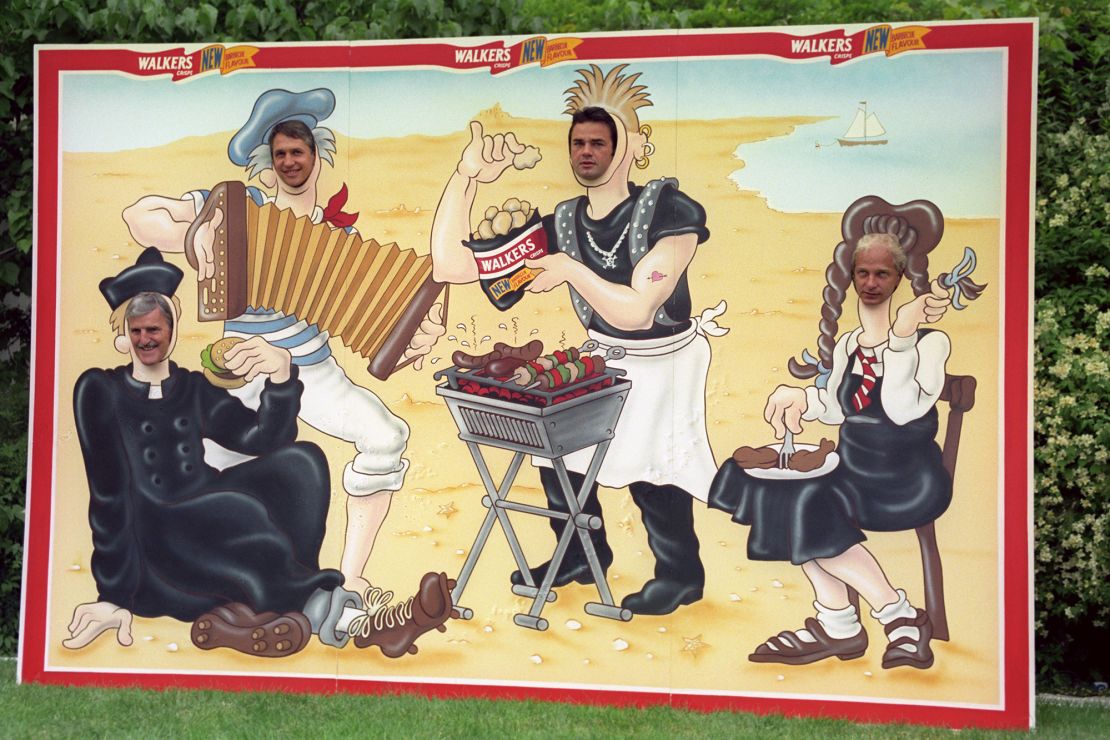
So began a beautiful friendship. During the 1990s Lineker played the hammy villain opposite A-listers like the Spice Girls, Bugs Bunny and his former England teammate Paul “Gazza” Gascoigne. For a while, the brand’s Salt and Vinegar crisps were even renamed “Salt and Lineker.” Increasingly, kids became the target of these campaigns; not just thanks to an ever-swelling medley of flavors, but the promise of free Mega Fiddler toys and Star Wars Tazos slipped inside packets.
Crisps now inhabited the same universe as football, pop music, movies and cartoons. They even became a fashion accessory; Natalie Whittle writes in “Crunch: An Ode to Crisps” about how she’d shrink old crisp packets in the oven. These could then be used as things like earrings and key fobs. “My memory is lots of children revelling in crisps just as much as I did,” writes Whittle.
But a second kind of crisp had also taken wing, as the snack started to grow up.
Thick, posh, sophisticated
“I haven’t met anyone yet who has said they don’t like crisps. I’m not sure I could ever truly trust someone who said they didn’t!” says the drinks writer Neil Ridley. His 2024 book, “The Crisp Sommelier,” pairs 185 different styles and flavors of crisp with various wines, beers, hard ciders and cocktails (a fine white Burgundy “sits wonderfully,” Ridley recommends, with the light meatiness of a smoked ham crisp).
“As adults, we’re supposed to abandon the flavors of our childhoods as we grow up and explore more sophisticated tastes and flavors,” says Ridley, “So for me, ‘The Crisp Sommelier’ really taps into that fondness for nostalgic flavours and aligns it with the obviously more adult themes of alcohol pairing.”
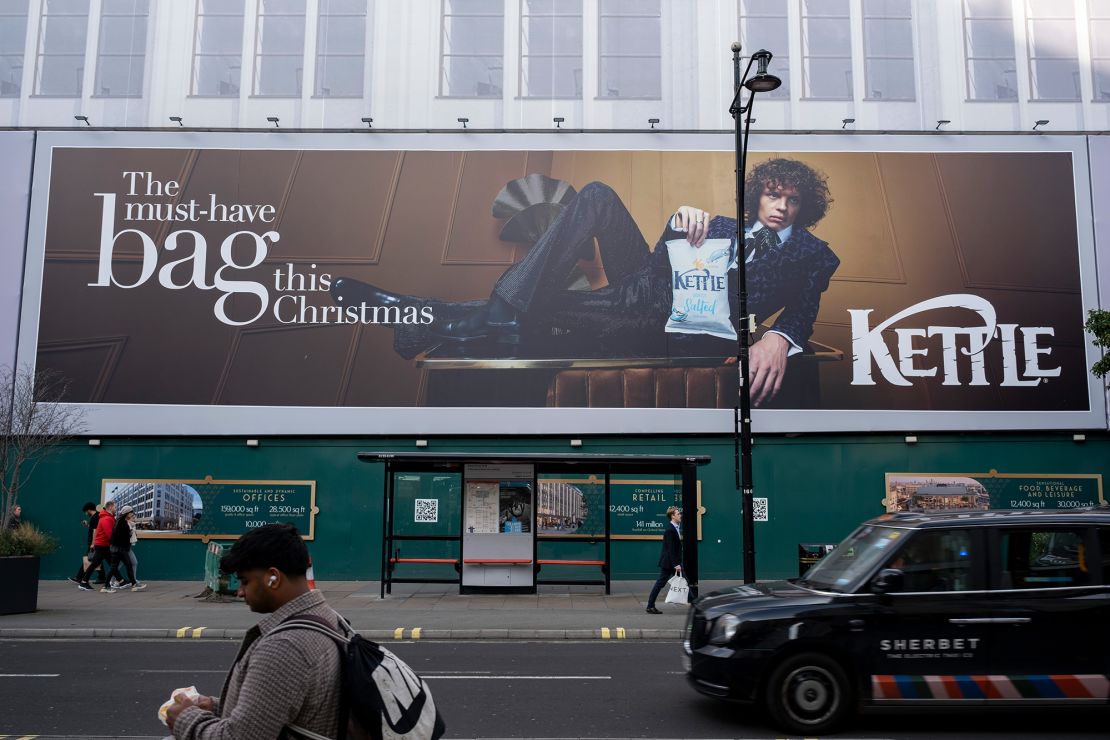
Ridley’s book also taps into a concept of crisp elevation which was already underway 40-odd years ago. In 1988, Kettle Brand Chips — first established in Salem, Oregon — established an outpost in Norfolk, England, bringing a thicker-cut crisp made from organic potatoes and oil to the British market. The bag was bigger, too, encouraging a sense of the deluxe and communal — something to pour into bowls at social gatherings and have people pick at while sipping their aperitifs. “I’m in heaven,” gushed a columnist for the Shields Daily Gazette local newspaper in 2001. “Kettle Chips has launched its latest seasonal edition… Sour Cream, Lemon and Black Pepper is the flavoursome snack to die for. Our friends popped round for Sunday tea and the Kettle Chips proved a huge hit.”
Crisps could now be aspirational for adults as well as kids, something to show off to friends and neighbors, like a new dress or television. Other “posh” brands followed suit. Tyrells — flaunting a rustic farmyard provenance, and potatoes with names like Lady Rosetta and Lady Claire — came onto the scene in 2002. Walkers ran with the herd, launching its Sensations range in 2002. Literally branded as “Posh crisps from Walkers,” these were initially promoted with the help of Victoria Beckham, aka Posh Spice, in a commercial which saw her famous soccer-playing husband being switched out for, you guessed it, Gary Lineker.
One nation under a crisp
In 2025, the quest for the perfect crisp continues. While this year’s Edinburgh Festival Fringe performance arts event includes a show about exactly that, current crisp trends include Slabs, comically chunky discs of potato that rail against the innate thinness of the crisp, come in flavors including Pan-Fried Egg, and can be sourced at trendy pubs like the Shirker’s Rest in New Cross, South London — where they encourage you to dunk it in another British culinary obsession: brown sauce. Meanwhile, harking back to crisps’ restaurant origins, Liverpool’s critically-acclaimed eatery Manifest has been praised for its “still warm” salt and vinegar crisps starter — perhaps not a million miles from the ones Cornelius Vanderbilt fell in love with back in 1853.
Long derided as a (literally) pale imitation of the British crisp, some European offerings have now caught the attention of Brits too. Torres crisps, made near Barcelona in Spain, come in flavors including Iberian Ham, and Extra Virgin Olive Oil, and have almost become a form of British tapas for the languorous middle classes.
Well-founded concerns around the health implications of a nation hooked on crisps (in 2006 the British Heart Foundation ran an infamous campaign showing a young girl chugging a bottle of cooking oil) mean that many healthier options are now on the table too, including crisps that are baked or roasted, rather than fried. Ingredients like root vegetables, lentils and chickpeas are increasingly used in place of the potato, though most crisp eaters would suggest that’s an entirely different taxonomy of snack altogether.
No one’s thrown in the towel on unearthing the next big flavor, no matter how abnormal that might turn out to be; a glance at Museum of Crisps’ preposterous list reveals a litany of Wonka-esque freaks: Candy Cane, Gin & Tonic, Rose Petal, Pumpkin Pie. Walkers alone has 125 flavors on British shelves at any one time, while its boffins toil away in “crisp test kitchens,” dreaming up more. Walkers fans pitch new flavor ideas to the company every single day. And yet, the truth is, the best crisp flavors were discovered a long time ago.

Cheese and Onion remains the most popular flavor of both Walkers and Tayto, despite being the first one ever trialed, almost 70 years ago. “These humble flavours have really stood the test of time,” says Stephanie Herbert, head of marketing at Walkers. When it comes to upmarket crisps, the classic flavors win out too. “Lye Cross Cheddar & Onion, Anglesey Sea Salt, and Burrow Hill Cider Vinegar are the top picks,” says Herbert, of the Pipers range, which Walkers owners PepsiCo bought out in 2019.
That most pedestrian of flavors, Ready Salted, isn’t far behind in the popularity polls, while Smith’s Salt ‘n’ Shake crisps, also now part of the PepsiCo stable, are still enjoyed by millions of Brits, who find the quirk of seasoning their own crisps an enjoyable ritual.
Neil Ridley, “The Crisp Sommelier” author, explains: “The bottom line is brands can premiumize crisps to their heart’s content, but they’re still a simple, affordable, fun-in-a-bag food that can operate at the highest echelons of society as well as the lowest. In short, they’re truly ours, as a nation.
“The potato crisp intertwines our social and cultural backgrounds, our childhoods and how we approach our working lives too. It’s a quick and easy way to travel around the world from flavor to flavor, it’s shareable, it evokes feelings of nostalgia and it also satisfies us in so many more ways than simply filling us up.”
Stephanie Herbert from Walkers agrees. “Few nations have embraced the crisp quite like Britain,” she says. “Crisps are woven into the fabric of everyday British life.
“In their own modest, distinctly British way, they’re as iconic as any national dish.”
Writer’s note: This article doesn’t touch on the wider definition of bagged British snacks, e.g. Skips, Scampi Fries, Frazzles, Chipsticks, Monster Munch. Although some readers might disagree, they’re not strictly crisps.


